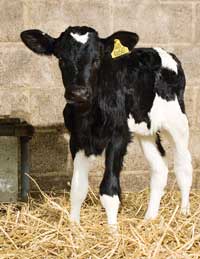Sire selection is crucial as dairy beef demand grows

Dairy bulls have long been viewed as a low value by-product of dairying. But with individual dairy bull calf prices up between £30 and £130, alongside concerns over animal welfare, they can offer a valuable source of income.
John Allen, managing partner of Kite Consulting, says with the growing demand for red meat, the prospects for meat generated from the dairy herd are significantly improved.
“We are entering a new phase for dairy beef. With the reduction in the national suckler herd, there is going to be increased demand for dairy beef. Dairy farmers should address sire selection to generate better beef alongside good heifer replacements.”
This attitude is shared by Richard Phelps of Blade Farming, and reflected in Blade’s new Star Sire Scheme.
“Holstein bull calves potentially have a significant value,” says Mr Phelps. “However, Blade has found 25% of bull calves are lost because of inadequate management, with another 25% rejected as a result of poor genetics.”
The Star Sire Scheme, acts to increase the value of dairy bulls by providing a list of sires that can produce dairy bulls more suited to the beef market, without compromising dairy heifer genetics.
“The scheme aims to validate the genetic worth of a dairy bull calf. Any dairy bull bred from a Star Sire Bull will be identified with an orange tag. This will help identify the bull to a prospective buyer as a good quality beef animal.
“The key is to get the tag out there and recognised as a common identifier of beef genetic worth.”
Data collected by Blade on calf grades has shown a high percentage of grade one calves have bulls in common, says Paul Westaway, beef farmer and chairman of the British Cattle Breeders Club.
“These calves are not tall and are wider in the chest and rump.
“We have been able to come up with a ranking of bulls to best fulfil this criteria while, fulfilling the main objective of dairy farming – to produce good quality heifer replacements”
“We have ensured bulls are the cream of the crop for dairy heifers.”
This has produced a list of six to eight bulls. “This is a completely dynamic and market-led list which is changed every four months in line with bull changes and new data from calf collections.”
Each of the eight bulls are quite different from each other, allowing farmers to select for a range of different traits depending on the genetic drive for their herd.
Dairy farmer, Sam Foot of Refined Holsteins, Weymouth, Dorset, has proved good quality dairy bulls can be produced without compromising dairy heifer genetics.
“Five years ago, our cows had become too angular and were simply not lasting. We made the decision to move away from the more extreme Holstein to a shorter and more robust cow.”
Better quality bull calves were secondary to this breeding strategy, but the financial and welfare benefits have been recognised by Mr Foot.
“It makes absolutely no sense for bulls to be shot.
“The public perception of bulls as a waste product is not good. When the industry can produce a more useful product it will be of benefit to all – reducing the number of imports and the number of bulls shot.”
Two out of the five bulls used at Refined Holsteins are from the Star Sire Scheme.
“We selected these bull to improve our heifer replacements, but at the same time we are producing better quality bull calves.”
By producing high quality bull calves, farmers can take advantage of current market prices. Stuart Hassall, auctioneer for Wright and Manley, Cheshire, has seen a 50% increase in the number of dairy bulls coming to market as a result of significant improvements in prices.
“Dairy farmers are now investing in calves that would previously have been shot. We are seeing better quality, stronger dairy bulls, which are achieving excellent money.
“Black-and-white bull calves that would have made £20 last year are now achieving £60-70 and those that would have gone for £60-70 are now making £100.”
In fact one farmer, with a herd of extreme Holsteins, sold a group of 14 calves that would have gone for £14 a head last year, for £145 a head last week, purely by investing a little more time.
